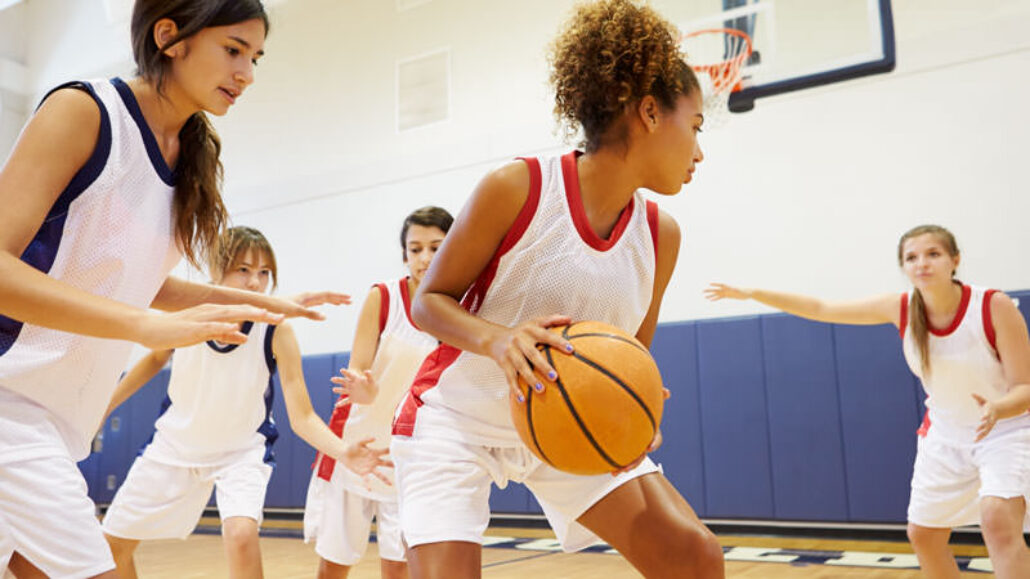Basketball is a fast-paced game with explosive action that puts particular stress on feet, ankles, and knees. Understanding how stress is linked to injury is the first step to prevention. We identify the basketball injuries we treat most frequently, and explain why they happen.
Basketball has come a long way since Dr. James Naismith invented it in 1891 to give his physical education class an indoor sport to play during harsh winter months. The first game ended in a brawl; one boy was knocked unconscious and other players sustained black eyes. There was even one separated shoulder. Today’s sport is less violent, but injuries still occur.
Players no longer use a soccer ball and two peach baskets to score, but basketball remains a fast game and a contact sport. Annual basketball-related injury estimates are over 1.6 million, and the U.S. Consumer Product Safety Commission has reported more than half a million injuries requiring emergency room treatment in a single year. The majority of these injuries are caused by player contact, falls, and abrupt direction changes on the court. Impacts with a flying ball can also cause injury. At Summit, the most common basketball injuries we see are a result of trauma or overuse.
Traumatic injuries are caused by sudden, forceful contact. In basketball players, the common traumatic injuries we treat include:
- Ankle sprains. Players experience sprains when the foot is rolled inward, twisted, or turned beyond the joint’s normal range of motion, stretching or tearing ligaments.
- Jammed fingers. This injury occurs when there is a hard impact between a moving ball and a fingertip, causing notable swelling in a single finger joint.
- Knee injuries. Players make extensive stop-and-go and cutting maneuvers during play. These movements can cause injury to the four major ligaments and menisci of the knee joint. Injury to the medial collateral ligament is most common. Gender differences in anatomy put girls at higher risk than boys for knee injuries, but players of both genders are vulnerable to knee trauma.
- Deep thigh bruising. These contusions are common in contact sports, and are the result of a direct blow to the front of the thigh.
- Facial cuts. Most facial injuries sustained by basketball players are relatively minor, though severe and permanent injuries have occurred.
Overuse injuries develop over time in players who regularly perform at an intense level. Older, higher-level players are more susceptible to these injuries than children and casual players. Common overuse injuries include:
- Stress fractures. The fractures we see are usually in the foot and lower leg. They occur when players increase their activity level too rapidly, or when they overtrain.
- Jumper’s knee. Also called patellar tendinitis, this overuse injury causes pain in the tendon just below the kneecap.
- Achilles tendinitis. This is an injury of the Achilles tendon, which connects the calf muscles to the heel bone. Overuse can make the tendon painful, and occasionally causes it to tear.
At Summit, we are committed to providing the preventative resources you need to keep you safe at every level of skill and competition. If you are injured, our sports medicine specialists are here with knowledgeable care and advanced medical treatments to support your recovery and return to your sport.
Summit Orthopedics offers comprehensive sports medicine expertise
From Olympians to pro athletes to kids in youth sports and those that just want to be more active—Summit Orthopedics delivers expert care by fellowship-trained sports medicine physicians. If you are recently injured or concerned about ongoing pain, Summit Orthopedics sports medicine specialists have the expertise to evaluate your discomfort and develop a plan to quickly and safely help you get back to being active.
Start your journey to stronger, healthier athletic condition. Find your sports medicine expert, request an appointment online, or call us at (651) 968–5201 to schedule a sports medicine consultation.
Summit has convenient locations across the Minneapolis-St. Paul metro area, serving Minnesota and western Wisconsin. We have state-of-the-art centers for comprehensive orthopedic care in Eagan, MN, Vadnais Heights, MN, Plymouth, MN, and Woodbury, MN, as well as several additional community clinics.
More resources for you
- Safety Equipment A Basketball Player Needs
- High School Basketball Injury Prevention
- Treatments For Common Basketball Injuries
- Know The Most Common Soccer Injuries
- Baseball: Know The Most Common Injury Risks
